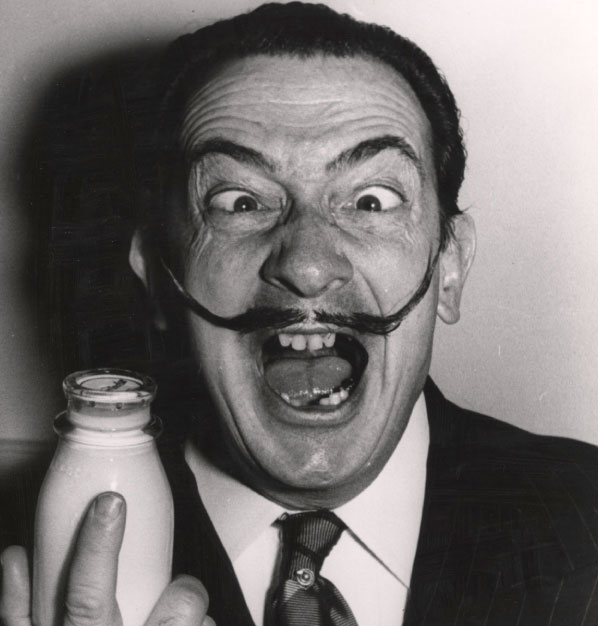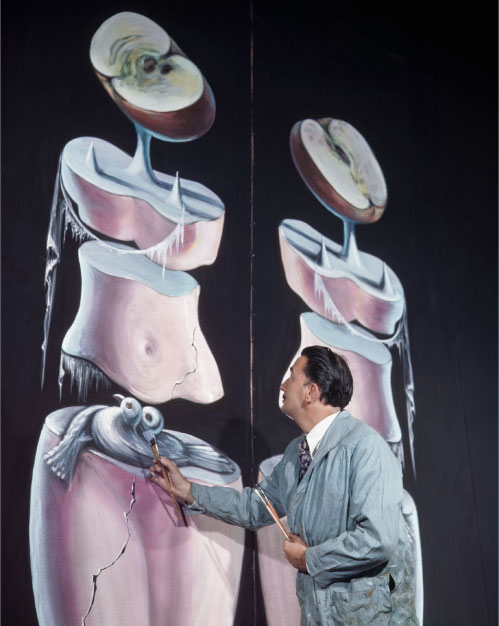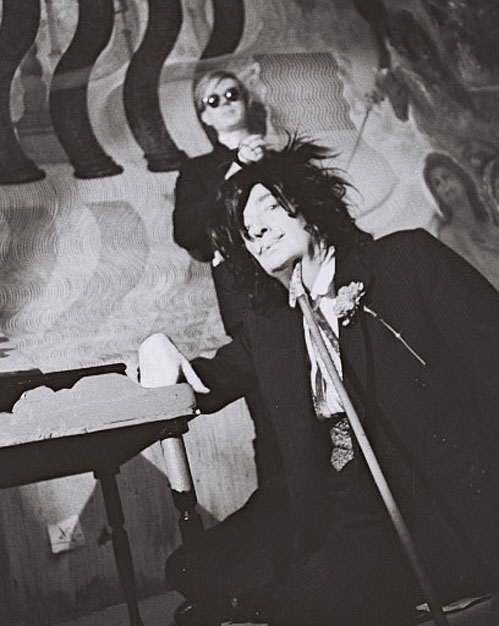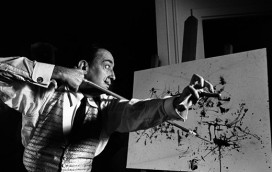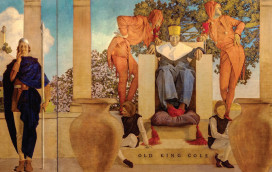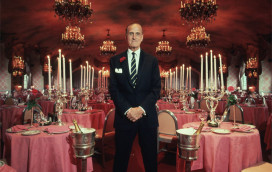DALÍ… IS… HERE!” For 40 years this gutteral cry announced that the greatest artist of the 20th century, certainly in his own estimation, had arrived in New York at his own private fiefdom, the fabled St. Regis. And whether it was in the hushed acreage of the restaurant, the lofty grandeur of the lobby, the dark enclave of the King Cole Bar or his gilded suite with adjoining studio, Salvador Dalí adored turning this hotel into the stage of his celebrity, his one-man theatre, his private palace and zoo.
Every winter from 1934 Dalí would appear like clockwork, or rather like some distorted cog from his own surreal timepiece, to occupy Room 1610, accompanied not only by his wife and muse Gala, but also a bizarre retinue of associates and animals, including his pet ocelot named Babou. Here he would happily swish around in his golden cape of dead bees or “accidentally” let loose a large box of flies. With arms stretched wide, cane held high, moustaches pointing to the heavens, nobody knew better how to make the grandest entrance. Soon not just fans but also tourists would congregate around the hotel hoping for a sighting of him on the steps of East 55th Street, growling his war cry, each loud sung syllable: “Da-lí… is… he-re!”
No city was better suited than New York to Dalí’s unique brand of showmanship and entrepreneurial hustle, “brand” being the mot juste for this groundbreaking artist who managed to turn himself into a business model and a limited-edition luxury product endorsed by the rich and famous. And no venue suited Dalí better than The St. Regis. (In fact few hotels are as closely associated with one particular artist as The St. Regis and Salvador Dalí.) For New York has as voracious an appetite for culture as for celebrity and commerce, and Dalí was the first to conquer the city by combining all these into one irresistible package: high art and high finance, and every sort of hijinks in between. Dalí’s true celebrity, his serious worldwide fame, was entirely due to the Manhattan media machine. There was an almost symbiotic relationship between the artist and the city’s press, feeding off each other in a mutual frenzy of outrage, a tornado of publicity stoked by Dalí’s pranks and posturings, as if neither could ever get enough of the other.
None of this was an accident, Dalí having plotted it all from the first time he stepped off a boat in New York. He understood that to be a truly modern artist in this one truly modern city he had to become a mainstream star. Which is why, when he arrived in Manhattan before World War II on the steamship Champlain, at the end of an expensive marine expedition from Le Havre subsidised by Picasso, nothing was left to chance. He had even prepared his own publication for the occasion, a broadsheet with the splendid title New York Salutes Me!, which was distributed on the ship and then to the awaiting newsmen when he stepped down the gangplank into New York for the first time ever, on November 14, 1934. Dalí had well and truly arrived.
The mutual attraction between the artist and the media when he stepped off the ship was immediate. In fact, when asked to single out his favorite work of those he had brought on the ship with him, he had one already prepared. Theatrically ripping away the wrappings, he revealed his chosen masterpiece: a portrait of his wife Gala with lamb chops on her shoulders, which made not just the next day’s papers, but that evening’s edition. By the end of his very first day, Dalí was already a hot gossip item.
And so the adulation continued. His debut exhibition at the Julien Levy Gallery proved an instant success, and he gave a hugely successful talk at MoMA. Soon, he was being photographed wherever he went. His famous “Bal Onirique” costume ball in honor of his return to Europe, organized by the bohemian Bostonite Caresse Crosby, was so outrageous that the next day there was a maelstrom of publicity, with photographs of his head bandaged in hospital gauze as he danced under a giant cow’s carcass.
Not that the artist stayed away too long. He soon set a pattern of travel, returning every winter, starting in December 1936 with another Julien Levy show that coincided neatly with the MoMA show Fantastic Art, Dada, Surrealism. This was accompanied by the ultimate accolade: a portrait by Man Ray on the cover of Time magazine, which dominated the newsstands and ensured that Dalí would have to sign autographs in the street for as long as he stayed in the city. As Time put it, “Surrealism would never have attracted its present attention in the US were it not for a handsome 32-year-old Catalan.”
Just as successful as his art-pieces were Dalí’s windows for Bonwit Teller department store, where crowds jostled six-deep on 5th Avenue to admire his surrealist woman with a head of roses complete with red lobster telephone. It was in these windows, in 1939, that Dalí staged possibly his most famous New York stunt, climbing into a bathtub in a window and then crashing through the plate glass – with the bath – to thunderous applause.
For Dalí, the best thing about this event was actually to be arrested and to spend time in a real New York prison with real American criminals, before being given a suspended sentence for disorderly conduct. As he admitted, it was “the most magical and effective action” of his entire life.
In spite of this, the artist was soon asked to create one of his most important commissions: his own pavilion at the World’s Fair of 1939, which he called Dream of Venus. In typical style, he came up with an outrageous plan, featuring semi-naked swimmers, and when sponsors objected, he wrote one of the best works of his life, Declaration of the Independence of the Imagination and the Rights of Man to His Own Madness, copies of which were showered over the city by aeroplanes as a full-scale public protest.
There was nothing more he loved than being noticed. As Nicolas Descharnes, the world’s leading Dalí expert, and son of his official personal secretary, Robert Descharnes, explains, “I remember my father recalling a walk with Dalí near The St. Regis Hotel in the 1970s, during which he was dressed in a black coat of panther skin, trying in vain to attract the attention of passersby while gesticulating with his stick. ‘Descharnes, have you seen?’ the artist apparently said. ‘It’s incredible how one can pass unnoticed in this city!’ ”
New York represented absolute energy for Dalí in his annual circuit between Paris, New York and his home in Port Lligat on Spain’s Costa Brava. It’s the city where he dynamized his career, whether during his long residence in America from 1940 to 1948 – when his and Léonide Massine’s ballet Labyrinth was shown at the Metropolitan Opera House, and he had a full retrospective at MoMA – or the winters near the end of his life.
Most of his meetings were in his “résidence d’hiver en St. Regis”, where he’d often hold court looking down on visitors from his 7ft chair, installed on the backs of four turtles. It was here that some of his most important engagements took place, whether that was receiving Helena Rubinstein’s commission to create her frescoes, or meeting for the first time the collectors Eleanor and Reynolds Morse, who went on to create the Dalí Museum in St. Petersburg, Florida. It was in this suite, in 1965, that he first met the young Andy Warhol, that ultimate New York artist. On a subsequent encounter he dressed Warhol up in an Incan headdress before tying him to a spinning wheel and pouring paint all over him.
It was also in 1965 that a remarkable film, Dalí in New York, was made, capturing all the magic and madness of the maestro in residence. Directed by a young Englishman, Jack Bond, the documentary captures Dalí and his circus preparing for his largest exhibition yet, at the Huntington Hartford Gallery. Bond himself stayed in a suite at The St. Regis and in the film we see much of the hotel of the era and Dalí’s “special relationships” with its residents and staff, including the famous waiter Stanley. We also see just how difficult Dalí could be. During one scene, he is filmed demanding 5,000 large black ants (having previously insisted on a sequence of exploding swans, much as at the World’s Fair he had initially conceived a set of exploding giraffes).
As Bond explains, “Dalí always knew exactly what he wanted and he got it. The doormen had to pay Dalí’s taxi fare. He was ‘grand’ in the real meaning of the word. He fitted New York like a glove, it was made for him, and The St. Regis was, and still is, the best hotel in the whole city. He was even able to paint there – he kept a special room as his studio.”
Bond’s film about New York is on permanent show at the Dalí Museum in Florida, a fitting homage to the importance of that one city, and one hotel, in the artist’s life, the place where he turned even his social world into one fantastic happening. As Hank Hine, director of the museum, puts it, “One of our greatest Dalí works is from 1976 and is entitled Gala Contemplating the Mediterranean Sea Which at Twenty Meters Becomes the Portrait of Abraham Lincoln (Homage to Rothko). This masterpiece was painted in the studio that Dalí kept at The St. Regis. The hotel is a living reminder of the vitality of the life of the city and the special vibrancy of great hotels.”
The Dalí Museum is at 1 Dalí Boulevard, St Petersburg, Florida; dali.org
Your address: The St. Regis New York; The St. Regis Bal Harbour Resort
Images by Getty Images, Bradley Smith/Corbis, Bettmann/Corbis, WireImage, David McCabe
